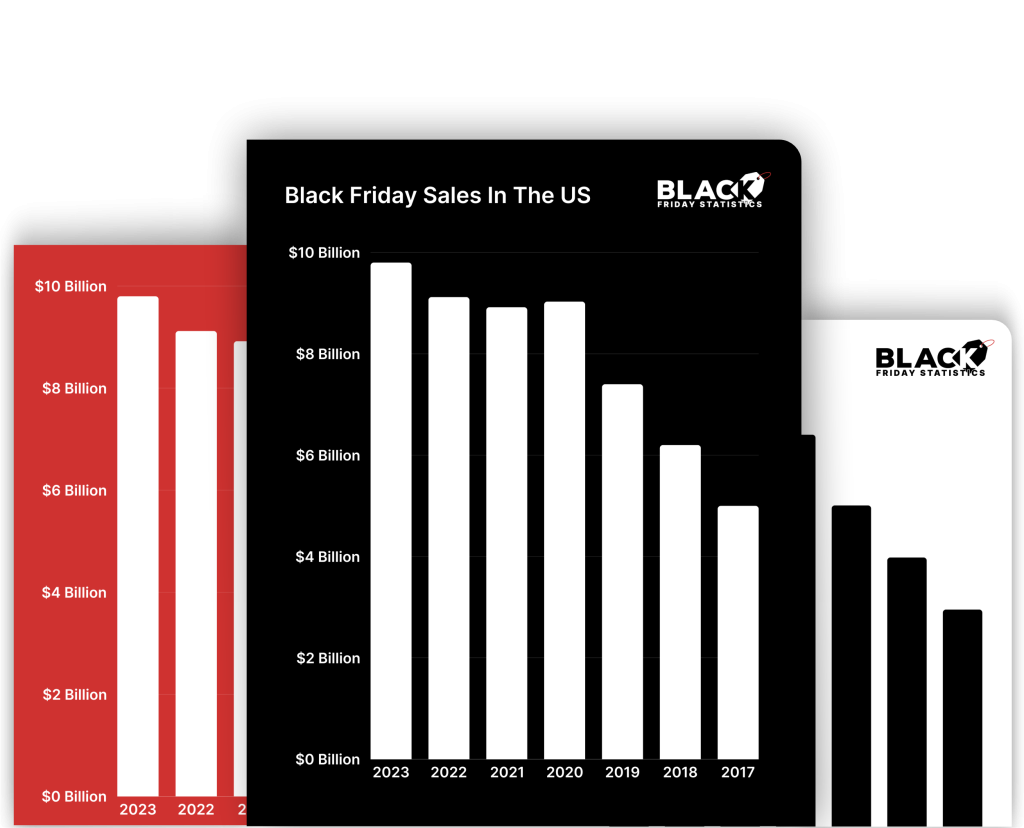
Black Friday 2024 made headlines with record-breaking sales and shifting consumer behaviors, marking a standout moment in the holiday shopping season.
This year, preliminary data indicates that online shopping reached $10.8 billion in the United States, reflecting a significant increase of 10.2% from previous years.
Besides, the global spending hit a new record on Black Friday, with $74.4 billion spent, marking a 5% increase compared to the previous year.
The influence of mobile devices and generative AI continues to grow, with more shoppers opting for the convenience of purchasing on smaller screens. Additionally, innovative payment options like “Buy Now, Pay Later” are reshaping the way consumers approach their holiday spending.
In this Black Friday Statistics report, we will go through the latest statistics and trends from Black Friday 2024, highlighting key insights from major retailers and platforms like Shopify.
Top Black Friday Statistics 2025 (New Data)
- Record Online Spending: In the US, consumers spent $10.8 billion online on Black Friday 2024, confirming a 10.2% increase from last year, where spending was reported at $9.8 billion. (Adobe)
- Around 87.3 million shopped online, and 81.7 million people shopped in stores on Black Friday 2024. (Adobe)
- Globally, Salesforce said spending also reached a new high: $74.4 billion was spent in the 24-hour period, up 5% from a year ago. (Salesforce)
- BNPL Spending: People spent $686.3 million using BNPL for online purchases, showing an 8.8% increase compared to last year. (NRF)
- Mobile Shopping Growth: Globally, 69% of Black Friday purchases were made on mobile devices, slightly up from 68% in 2023. (Salesforce)
- Cyber Monday sales: Cyber Monday saw a big jump in sales, reaching $13.3 billion, up $0.9 billion from last year. (Adobe)
Black Friday Sales 2024— Latest Reports
Black Friday online sales in the United States hit $10.8 billion in 2024, a 10.2% increase from the previous year.
According to Adobe, this was the highest Black Friday sales figure ever recorded.
Between 10 a.m. and 2 p.m. on Friday, online shoppers were spending an average of $11.3 million per minute, as reported by Adobe.
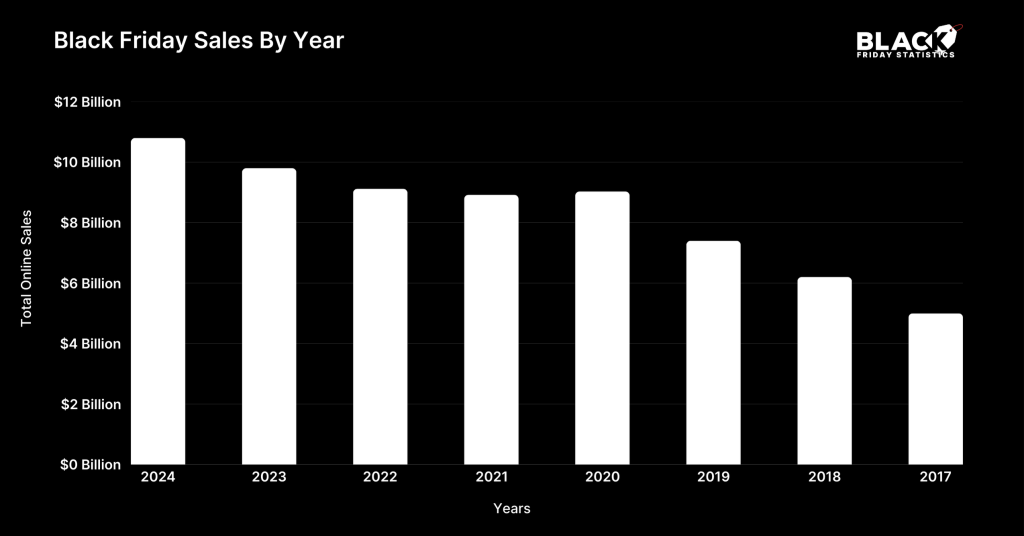
Here is a table displaying the Black Friday sales by year:
| Years | Total Online Sales |
|---|---|
| 2024 | $10.8 billion |
| 2023 | $9.8 billion |
| 2022 | $9.12 billion |
| 2021 | $8.92 billion |
| 2020 | $9.03 billion |
| 2019 | $7.4 billion |
| 2018 | $6.2 billion |
| 2017 | $5 billion |
Meanwhile, Salesforce reported that Black Friday sales in 2024 reached $17.5 billion, reflecting a 7% year-over-year increase.
On the other hand, Mastercard reported a 14.6% growth in online sales in the United States compared to 2023. In contrast, brick-and-mortar store sales only saw a small increase of 0.7% year-over-year.
Source: Adobe, Salesforce, Mastercard.
Shoppers broke records this Thanksgiving, spending $6.1 billion online, an increase of 8.9% from last year.
Veteran’s Day sales in 2024 climbed to $3.3 billion, marking a 6.5% rise, while Thanksgiving Eve brought in $4.1 billion, up 5.1%.
Cyber Monday also saw significant growth, with online sales hitting $13.3 billion, a $0.9 billion increase compared to the previous year.
The surge in spending is largely driven by massive discounts, especially in toys, where prices have been slashed by over 27%.
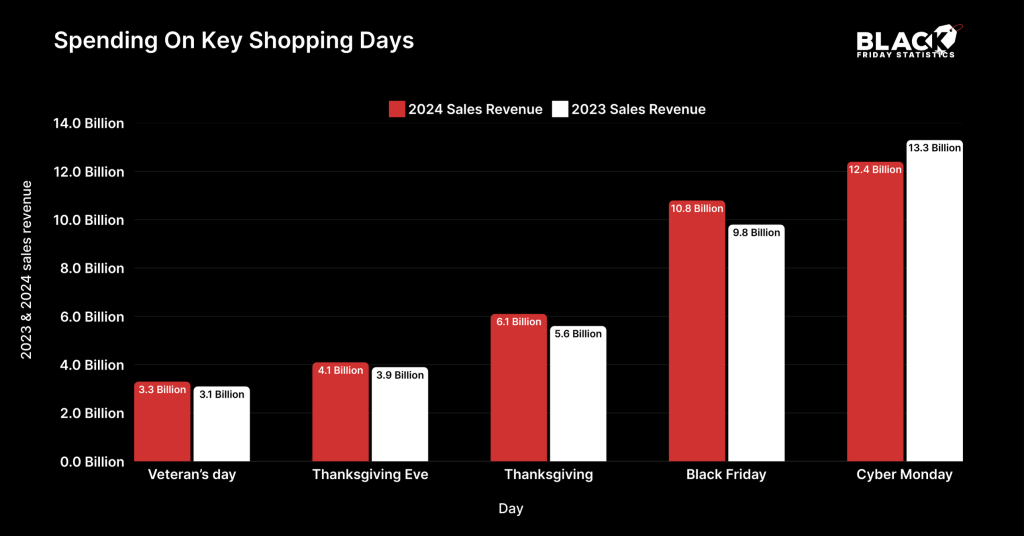
Below is a table showing customer spending on key shopping days during Black Friday week in 2023 and 2024:
| Day | 2024 Sales Revenue | 2023 Sales Revenue |
|---|---|---|
| Veteran’s day | $3.3 billion | $3.1 billion |
| Thanksgiving Eve | $4.1 billion | $3.9 billion |
| Thanksgiving | $6.1 billion | $5.6 billion |
| Black Friday | $10.8 billion | $9.8 billion |
| Cyber Monday | $12.4 billion | $13.3 billion |
Source: Adobe Business.
On Black Friday, 81.7 million consumers shopped in stores, up from 76.2 million last year, marking the highest in-person turnout since the pandemic.
Meanwhile, 87.3 million people shopped online, a slight dip from 90.6 million recorded in 2023.
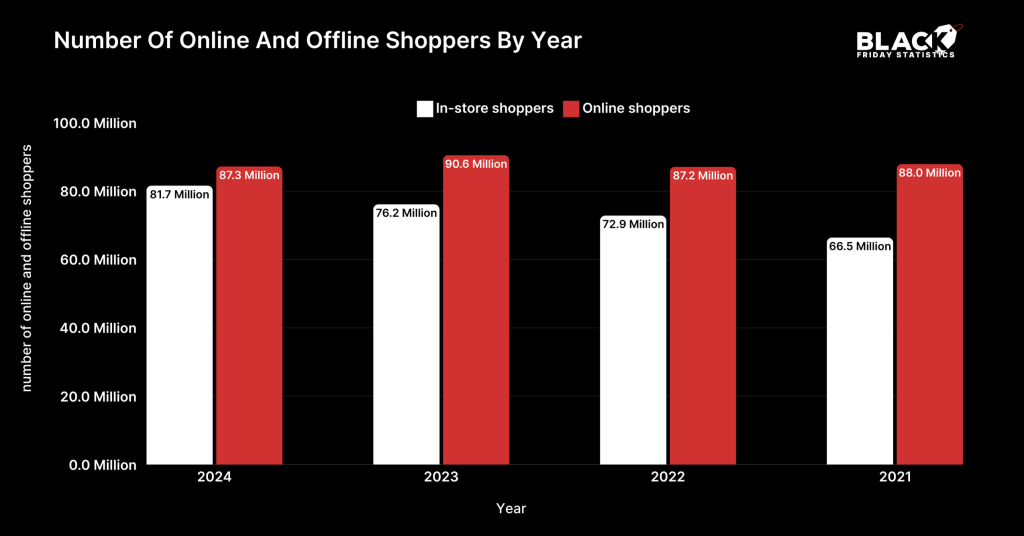
The following table shows the number of online and offline shoppers by year:
| Year | In-store Shoppers | Online Shoppers |
|---|---|---|
| 2024 | 81.7 million | 87.3 million |
| 2023 | 76.2 million | 90.6 million |
| 2022 | 72.9 million | 87.2 million |
| 2021 | 66.5 million | 88 million |
Source: National Retail Federation
Amazon’s estimated sales during Black Friday 2024 were around $900 million.
According to Enjoy Aiia, Amazon’s estimated sales during Black Friday 2024 were around $900 million, fueled by high demand for electronics, toys, and beauty products.
The company reported its largest 12-day holiday shopping event to date, with over 60% of sales coming from independent sellers.
Amazon also maintained the lowest online prices, averaging 14% lower than other major U.S. retailers, contributing to its record-breaking performance.
Buy Now, Pay Later (BNPL) spending accounted for $686.3 million in online purchases, marking an 8.8% year-over-year increase.
According to Adobe’s pre-holiday survey, around 20% of shoppers turned to BNPL to ease their cash flow, while another 20% used it to afford items they wouldn’t have been able to buy otherwise.
The rise in BNPL usage can be attributed to the growing number of shoppers using mobile devices and the increasing number of retailers integrating BNPL options into their checkout processes, making it more convenient for customers.
Source: Adobe.
AI and AI agents significantly drove over $14 billion in global online sales on Black Friday.
Retailers that incorporated generative artificial intelligence into their operations saw a 9% higher conversion rate compared to those that didn’t.
AI-powered chatbots have had a significant influence on consumer behavior. Bot-driven clicks to retail sites skyrocketed by an impressive 1,800% compared to the previous year.
According to an Adobe survey, 20% of shoppers reported using chatbots to find deals, with 19% using them to search for specific items and 15% seeking brand recommendations.
Source: Salesforce, Adobe.
In 2024, consumer spending rose by 4%, with average order values increasing by 3% year-over-year.
Nearly every product category saw triple-digit sales growth on Black Friday, though the increase was slightly lower than in 2023.
Toys and games led the sales boost, followed closely by apparel and accessories, which saw the second-highest increase.
Here is a table displaying the increase in sales compared to a normal day by category:
| Product Category | Black Friday 2024 | Black Friday 2023 |
|---|---|---|
| Toys & Games | +412% | +596% |
| Apparel & Accessories | +374% | +393% |
| Luggage & Bags | +357% | +397% |
| Electronics | +355% | +449% |
| Sporting Goods | +335% | +367% |
| Home & Garden | +326% | +342% |
| Health & Beauty | +304% | +314% |
| Furniture | +273% | +339% |
| Food, Beverages & Tobacco | +249% | +234% |
Source: Criteo
Shopify merchants reached a new milestone this Black Friday, with $4.1 billion in sales, up 22% from last year.
Sales peaked at 12:01 p.m. EST, with transactions soaring to $4.6 million per minute.
The average cart value on Black Friday was $110.71, or $110.08 after currency adjustments. Additionally, Shopify POS saw a significant 33% year-over-year increase in global sales, highlighting strong growth in both online and in-person purchases.
Further, during the Black Friday Cyber Monday weekend, Shopify merchants achieved a record-breaking $11.5 billion in sales, marking a 24% increase from the previous year.
Here are some insights about Shopify sales recorded during the Black Friday-Cyber Monday sale:
- Over 76 million consumers worldwide shopped from Shopify-powered brands
- More than 16,500 entrepreneurs made their first sale on Shopify
- Over 67,000 merchants had their biggest sales day ever on Shopify
- The top-selling product categories were Clothing Tops, Cosmetics, Fitness & Nutrition, Pants, and Activewear.
- The average cart value was $108.56, or $109.70 when adjusted for constant currency.
- The leading countries for sales were the US, UK, Australia, Canada, and Germany.
- The top cities for sales included Los Angeles, New York, London, San Francisco, and Miami.
- Cross-border orders accounted for 16% of all global orders.
- Sales through Shop Pay saw a 58% year-over-year increase.
- The Shop App tracked over 91 million packages globally.
Black Friday Sales Worldwide (Latest Data)
Globally, online Black Friday spending hit an impressive $74.4 billion, as per Salesforce’s latest report, marking a 5% year-over-year (YoY) increase.
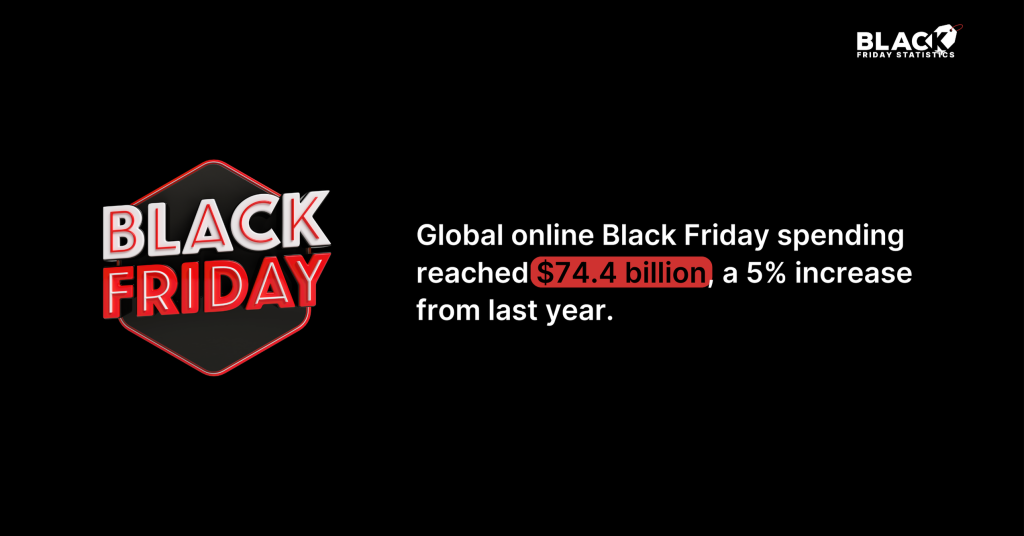
Last year, worldwide Black Friday sales were estimated at $70.9 billion.
Cyber Week sales also broke records with $314.9 billion worldwide, up 6% from the previous year.
Thanksgiving contributed significantly to this trend, with online sales totaling $33.6 billion, also up 6% from the previous year.
Mobile devices played a major role in this surge, accounting for 70% of all online orders globally, including in the US. Altogether, mobile shopping generated an incredible $220 billion in global sales.
Shoppers enjoyed an average discount of 26% during Cyber Week, with makeup products standing out by offering the deepest discounts at 40%.
Here are further details about the categories with the highest discounts recorded during the cyber week:
- Makeup (40%)
- General apparel (34%)
- Skincare (33%)
Source: Salesforce, Techcrunch.
Black Friday Discount Statistics
Black Friday discounts across product categories ranged from 11% to 23%.
The biggest savings were seen in apparel and accessories, while more expensive electronics, such as TVs and laptops, offered more modest discounts.
The highest discounts were found on items like earrings, rings, shirts & tops, pants, and coats & jackets.
Here is a table displaying the average discount offered on various items in the United States.
| Product Category | Average Discount |
|---|---|
| Earrings | 23% |
| Rings | 22% |
| Shirts & Tops | 22% |
| Pants | 22% |
| Coats & Jackets | 22% |
| Dresses | 20% |
| Necklaces | 19% |
| Shoes | 19% |
| Computer Monitors | 17% |
| Headphones & Headsets | 16% |
| Video Game Consoles | 16% |
| Watches | 15% |
| Mobile Phones | 14% |
| Perfume & Cologne | 13% |
| Laptops | 13% |
| Televisions | 11% |
Source: Criteo
Holiday Shopping Statistics
Black Friday saw the highest number of shoppers, both online and in-store, in 2024.
Cyber Monday remained the second most popular day for online shopping, with 64.4 million consumers, a slight drop from 73.1 million in 2023.
The day after Black Friday, however, was the second busiest day for in-store shopping.
Here is a table displaying the number of online and in-store shoppers recorded in the Black Friday week.
| Day | In-store Shoppers | Online Shoppers |
|---|---|---|
| Thanksgiving | 26.1 million | 28.6 million |
| Black Friday | 81.7 million | 87.3 million |
| Saturday | 61.1 million | 53.9 million |
| Sunday | 25.6 million | 32.8 million |
| Cyber Monday | 23.2 million | 64.4 million |
Source: National Retail Federation
The Thanksgiving to Cyber Monday holiday weekend attracted an estimated 197 million shoppers.
Many shoppers balanced convenience by choosing both in-store and online options. In-store shopping saw a rise, with 126 million people visiting stores, up from 121.4 million in 2023.
However, online shopping dipped slightly, with 124.3 million shoppers compared to 134.2 million last year.
Here’s a table showcasing the total number of shoppers recorded during the Thanksgiving to Cyber Monday period:
| Year | Number Of Shoppers |
|---|---|
| 2024 | 197 million |
| 2023 | 200.4 million |
| 2022 | 196.7 million |
| 2021 | 179.8 million |
| 2020 | 186.4 million |
| 2019 | 189.6 million |
| 2018 | 165.8 million |
| 2017 | 174.6 million |
Source: NRF
During the 2024 holiday season, consumer spending reached an impressive $241.1 billion, reflecting an 8.6% increase from 2023.
This marks the highest growth rate in recent years.
In comparison, 2023 saw $222.1 billion in spending, which was up by 4.9% from 2022.
The overall trend indicates a steady rise in consumer spending, with 2024 standing out for its record-breaking spending and growth, while 2022 experienced slower growth.
The following table displays the consumer spending recorded during the Black Friday holiday season over the years.
| Year | Consumer Spending | Percentage Increase |
|---|---|---|
| 2024 | $241.1 billion | 8.6% |
| 2023 | $222.1 billion | 4.9% |
| 2022 | $210 billion | 2.5% |
| 2021 | $205 billion | 8.6% |
Source: Adobe
Paid search accounted for 29.7% of holiday sales revenue, reflecting a 1% year-over-year increase.
Meanwhile, affiliates and partners, including influencers, experienced even stronger growth, rising by 6% to reach 17.6%.
Influencers were especially effective, converting shoppers at a rate 9 times higher than social media as a whole. Additionally, 37% of Gen Z shoppers made purchases based on influencer recommendations.
Source: Search Engine Journal
During the holiday season, 54.47% of sales came from mobile phones, while 45.53% were made on desktops.
The Adobe Analytics Report revealed that mobile shopping generated $131.5 billion in revenue, with its share continuing to grow in recent years. In comparison, desktop shopping accounted for $109.9 billion in revenue.
Here is a table displaying the share of mobile purchases during the holiday season:
| Year | Share Of Mobile Purchases |
|---|---|
| 2024 | 54.5% |
| 2023 | 51.1% |
| 2022 | 47.1% |
Source: Adobe.
Consumers spent a total of $18.2 billion using Buy Now, Pay Later (BNPL) during the 2024 holiday season, reflecting a 9.6% increase compared to the previous year.
Cyber Monday set a new single-day record for BNPL with $991.2 million in sales.
Mobile devices accounted for the majority of BNPL purchases, totaling $14.4 billion (79.12%), while desktop purchases made up $3.8 billion (20.88%).
The 2024 holiday season saw the highest BNPL spending to date, surpassing the $16.6 billion spent during the 2023 holiday season.
Here is a table showing the BNPL spending during the holiday season by year:
| Year | BNPL Spending During The Holiday Season |
|---|---|
| 2024 | 18.2 billion |
| 2023 | 16.6 billion |
| 2022 | 14.5 billion |
Source: Adobe
This holiday season, traffic to retail sites from AI-powered chatbots surged by 1,300% compared to the previous year.
Cyber Monday experienced the biggest spike in chatbot usage, increasing by 1,950% year-over-year.
Although the number of users is still modest, this growth highlights the rising importance of chatbots as effective shopping assistants. In an Adobe survey of 5,000 U.S. consumers, 70% of those who have used generative AI for shopping reported a better overall shopping experience.
Source: Adobe.
Conclusion: Black Friday Spending Reached $10.8 Billion In United States
Black Friday 2024 was a record-breaking shopping event, with global online sales reaching an impressive $74.4 billion, showing a 5% increase from the previous year.
In the U.S., both in-store and online shopping numbers surged, with 76 million shoppers hitting physical stores and 87.3 million shopping online. Mobile shopping continued to lead, making up 54.47% of total sales.
Additionally, the popularity of Buy Now, Pay Later (BNPL) services grew significantly, with consumers spending $18.2 billion through BNPL.
